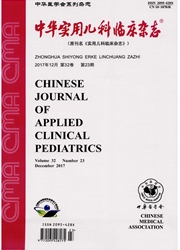

 中文摘要:
中文摘要:
目的 明确ATP敏感钾通道在预先应用左旋甲状腺素钠对抗未成年大鼠离体心脏缺血再灌注损伤中的作用。方法 将日龄35 d的未成年健康雌性Wistar大鼠32只随机分为4组(每组8只):空白对照组(BC组)、对照组(C组)、左旋甲状腺素钠100 μg组(100 μg组)和格列本脲+左旋甲状腺素钠组(G+L组)。BC组和C组大鼠实验前应用普通饲料喂养7 d;除普通饲料喂养外,100 μg组和G+L组大鼠每天通过灌胃方式应用左旋甲状腺素钠100 μg·kg-1进行预处理。第8天麻醉后取出大鼠心脏,采用Langendorff装置建立离体心脏缺血再灌注模型,BC组离体心脏持续灌注80 min,中间不实施停灌注,余各组的离体心脏则均顺序经历平衡30 min、常温停灌注20 min和再灌注30 min处理。G+L组采用含有格列本脲30 μmol·L-1的Krebs-Henseleit缓冲液(KH液)灌注,而其他组采用KH液灌注。实验中连续监测心率、收缩压、左心室压力上升的最大速率(dp/dtmax)和左心室压力下降的最大速率(dp/dtmin)等血流动力学指标;测定平衡期和再灌注期的冠脉流量及再灌注期冠脉流出液中心肌型肌酸激酶同工酶(CK-MB)活性;再灌注后取心室肌组织标本,采用Western blot技术检测热休克蛋白70(HSP70)的表达,采用实时定量RT-PCR技术检测肌球蛋白重链(MHC)和甲状腺激素受体(TR)mRNA的表达。结果 与C组比较,100 μg组和G+L组再灌注期全部血流动力学指标及平衡期和再灌注期冠脉流量均显著增高,且100 μg组和G+L组平衡期冠脉流量显著高于BC组。100 μg组和G+L组再灌注期冠脉流出液CK-MB活性显著高于BC组,但显著低于C组。100 μg组和G+L组心室肌组织HSP70和MHCα mRNA表达显著强于BC组和C组。100 μg组和G+L组所有检测指标比较差异均无统计学意义。4组心室肌组织TR mRNA表达比较差异均无统计学意义。 结
 英文摘要:
英文摘要:
Objective To verify the role of adenosine triphosphate(ATP) sensitive potassium channel in protection of preemptive levo- thyroxine - sodium administration against myocardial ischemia - reperfusion injury in isolated inmmture rat heart models. Methods Thirty - two healthy,female immature ( aged 35 days) Wistar rats were randomly allocated into 4 groups ( n = 8 each ) : blank control group ( group BC ), control group ( group C ), levothyroxine - sodlnm 100 μg group ( group 100 μg) and combined glibenclamide and levothyroxine - sodium group ( group G + L). The rats in group BC and group C were fed with normal food for 7 days before experiment. Except for feeding with normal food for 7 days before experiment,the rats in group 100 μg and group G + L were also pretreatmented with levothyroxine sodium 100 μg·kg-1 , through a gastric tube every day. On the 8th day, the hearts were harvested front the anesthetized rats, and appended to a Langendorff apparatus for the isolated heart perfusion model. The isolated hearts in group BC were perfused for 80 minutes without zero - perfusion, whereas the hearts in other groups experienced in order a 30 minutes balance period, a 20 minutes normothermic zero - perfusion and a 30 minutes reperfu- sion period. The isolated hearts were perfused with Krebs - Henseleit fluid ( KH fluid) containing glibenclamide 30 μmol· L-1 in group G + L, and with KH fluid in other groups, respectively. The hemodynamic variables including heart rate, systolic blood pressure, peak rates of rise in the first derivative of left ventricular pressure ( dp/dtm~* ) and peak rates of fall in the first derivative of left ventricular pressure ( dp/dtmio ) were continuously monitored. The coronary perfosion flow was recorded during balance and reperfusion periods. During reperfusion period, the coronary perfusion fluid was collected to assay the cardiac enzyme - myocardial - bound creatine kinase ( CK - MB). At the end of perfusion, the ventricular musc
 同期刊论文项目
同期刊论文项目
 同项目期刊论文
同项目期刊论文
 期刊信息
期刊信息
